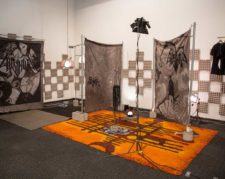This is part two of a two-part series featuring art museum registrars and the special challenges they face in working with site-specific and large-scale contemporary art pieces.
Ariana Webber is the Registrar for Exhibitions at the MIT List Visual Arts Center in Cambridge, MA. Below she talks about campus hacking culture, loan agreements for performance art, and the challenges of categorizing artwork for a US customs form.

Ariana Webber
Exhibitions on the Cusp (EOC): How long have you worked at the MIT List Center? Do you focus more on the permanent collection or on exhibitions?
Ariana Webber (AW): I have been at the List Center for just over a year now. When I first started here, I did a little bit of everything, permanent collections, public art, and exhibitions. We recently hired another registrar in our department, so now I am primarily focusing on exhibitions. It is so rare for registration departments to grow. We are extremely lucky and grateful to MIT and the List Center for understanding the importance of what we do and giving us the resources to do it well.
EOC: How did you get interested in being a registrar?
AW: I initially entered the museum field as a way to work more closely with objects. I really loved art and history and I wanted to immerse myself with it in a hands-on fashion. Besides getting a PhD (and most likely ending up spending most of my time in a library and not working with actual objects), I wasn’t sure where to begin. I started out by taking a few courses at Harvard in Museum Studies. I wanted to find out if museum work was really for me. I found I really enjoyed it and I learned that Registration and Collections Management were actual career options one could have. I was hooked the first time I heard someone describing the intricacies of international art shipping and the effects of temperature and relative humidity on different materials. I enrolled full-time in the Museum Studies Master’s program at NYU the following year and I haven’t looked back.
EOC: What are some of the special challenges in caring for contemporary art, particularly large-scale pieces?
AW: Caring for large scale contemporary art, specifically at MIT, presents some unique challenges. Many of our sculptures are outside, therefore we navigate the climate of Cambridge. MIT also has a large facilities and grounds staff who take care of the areas around the sculptures. So, when the List Center installs works on campus we need to think about how close lawn mowers and snow plows will try to come and think about ways to mitigate potential problems. We have to think about everything from tree sap dripping onto a sculpture to skateboarders thinking the Di Suvero looks like the perfect place to skateboard!
At MIT, we also have a culture of hacking around campus, which includes hacking our public sculptures. We have found a study center placed on top of the Louise Nevelson, a swing set on the Di Suvero, an entire living room set placed upside down on the I. M. Pei arch, as well as countless hats and other garments placed on our Jaume Plensa sculpture. There is an unwritten code for hacking art on campus. Everything they do is supposed to be reversible and cause no permanent damage. However, they don’t always realize that climbing up the sculpture to place things on top can cause damage in itself. So, part of my job is being a persistent advocate for the safety of the art. It is hard when the works are outside, spread across a vast campus and not always in your immediate control, but all in all, MIT’s students value the art on campus and help us ensure they are preserved for future generations of students.
EOC: What about exhibitions that include site-specific works, performance art, multi-media installations, and other non-traditional media? How does the List Center handle cataloguing those works in their permanent collection and how does the process differ from more traditional media?
AW: For exhibitions that include site specific works, some of the interesting questions that come up are what exactly is part of the art? The wall that we laid down as part of our current show with Heimo Zobernig is art during the show, but as soon as the show ends it goes back to being a wall that we will reuse for another show. The exhibition is a site-specific installation, but other elements of the show are going to be sent to a gallery after the show. When we shipped the elements to the List, they were not considered “art” yet. They were just commercial stages and blankets. But after being exhibited here, they became art and when they travel again, they will travel as art. But it is an interesting discussion exactly where that line is. This becomes especially interesting with site-specific art, where the architecture of the space contributes so much to the work being what it is.

Heimo Zobernig, “chess painting.” Installation view at MIT List Visual Arts Center, 2017. Photo: Peter Harris Studio.
We haven’t had any performance art at the List since I joined, but we will soon. So, this is something that I have been thinking about. Does the performance itself become a “work” lent to us? Does it need to be on a loan agreement or is there another type of agreement that would better reflect the nature of the work? What happens when objects lent to the show become active elements in the performance? How do we convey that the artist during the performance can touch this work, but visitors cannot?
One of the complicated things about collecting time based media works or works with non-traditional media, is constantly changing technology. Technology that was readily available when the artist was making the work, can in a short period of time become obsolete. When we acquire a work, we ask the artist: What part of the piece is actually integral to the work? What makes it integral? And what parts could be replaced over time by newer versions of the same technology? For example, are the exact type of light bulbs used in a work used for a specific reason or could we replicate the same effect with a different type of bulb later on? Do we need to stockpile these light bulbs now while they are available?
EOC: Can you give some details about the List Projects program?
AW: List Projects is an ongoing series of focused exhibitions complementing our main gallery programming. The program allows us to support the work of artists at pivotal points in their career and those otherwise lacking an institutional voice, from emerging to undiscovered or underrepresented artists. The program by nature is investigative and experimental, affording our curators the ability to react quickly and spontaneously. List Projects also augments our main gallery exhibition schedule, allowing us to remain open to the public throughout the year.
EOC: Can you give some details about the MIT Percent-for-Art program?
AW: Our Percent-for-Art Program is one of the first such programs at a private institution of higher education in the US and it is also one of the most active. The program allots 2% of a project’s budget, up to $500,000, to commission art for each new major renovation or campus construction project. The program was formally instituted in 1968, but there are earlier collaborations between artists and architects on MIT’s campus. When architect Eero Saarinen designed the MIT Chapel in 1955, sculptor Theodore Roszak designed the bell tower and sculptor Harry Bertoia designed the altar screen. In 1985, architect I.M. Pei and artists Scott Burton, Kenneth Noland, and Richard Fleischner collaborated on Percent-for- Art projects for the Wiesner building and plaza, where the List Center is located. More recent Percent-for- Art projects include Antony Gormley’s five-story tall sculptural installation, CHORD, for MIT’s Mathematics Department; and Leo Villareal’s Light Matrix (MIT), an LED light installation created for the North Vestibule entrance to the Morris and Sophie Chang Building at MIT’s Sloan School of Management.
EOC: MIT has a really interesting program for loaning artwork to students and faculty. Can you tell us a little more about this program?
AW: Every September, we hang around 600 artworks salon style in our galleries. Students have two weeks to view the exhibition and enter their top five choices in an online lottery system designed for us by MIT. Students who win the lottery are able to take their assigned work home to hang in their dorms and apartments for the year. We have a wide variety of artworks available for loan, everything from works by Bernice Abbott and Cerith Wyn Evans to Cindy Sherman and Fred Wilson. We issue loan contracts to each student and within a week all the works are deinstalled and out on campus. Our visitors services staff and preparator team help us distribute the artworks. A large portion of our permanent collection is available for loan to faculty and staff offices around MIT. Because we don’t have a permanent collection gallery, the MIT campus itself becomes our museum space. Staff and faculty make appointments with us to view the art available for loan and if they find something that works in their space, we schedule a time to install. We then follow up with loan paperwork and care guidelines. Any time they move offices, need to paint, or anything like that, we come and remove the artwork for them. MIT staff and faculty really appreciate this program and I have gotten wonderful feedback from them about it.
There are some faculty members who have had the same works in their office for 20 years and have become quite attached to them!
EOC: It seems the List Center has a strong focus in site-specific works, particularly in their exhibitions and special programming. Has this been a conscious decision? If so, why?
AW: I don’t think it has been a conscious decision per se but it is rather a byproduct of our space and individual artist’s reaction to it. I spoke with our curators, Henriette Huldisch and Yuri Stone, about this question. While they would not call our focus site-specific exactly, because we work with living artists and present new projects, the site inevitably is taken into consideration and impacts the work. Often the new projects speak directly to the unique context of the List Center, situated in an historic building designed by an iconic architect. Our real emphasis is on new work and production.
EOC: Can you talk about a recent exhibition where you worked on coordinating the travel of artwork or materials? Were there any specific shipping challenges due to the type of medium?
AW: We recently had an exhibition of works by the artist Charlotte Moth. One of her works was a spinning epoxy plant that had been 3D printed. The work was shipped from Europe. It also included a bottle of touch up paint. Shipping that paint ended up being more complicated from a customs standpoint than shipping the rest of the show. We had to be able to document the exact type of paint it was, and it was a European style of paint, so it didn’t show up on any of the standard drop down forms for US customs. The fact that it was a liquid also caused all sorts of problems. The plant itself was also complicated to ship. It was extremely fragile so we had to modify the crate and packing systems to better support the trip back. Shipping art involves a lot of thinking about what could possibly happen to this crate and how we can pack the object to withstand it.
One thing that we have to deal with a lot here at the List is lack of space (a situation common to many institutions!). We don’t have any crate storage or large packing space onsite, so we unpack everything in our galleries. That means that crates need to fit through our gallery doors (more of a problem than you would think) and we have to schedule the shipping and unpacking of works keeping in mind where all the crates and packing materials will be stored.
Another common challenge with shipping contemporary art is arranging shipments for works that the artists haven’t completed yet. It involves a lot of estimating what can fit into the truck and making best guesses about the final product.




Hi there, You’ve done an excellent job. I’ll definitely digg it and personally recommend to my friends. I’m sure they’ll be benefited from this web site. Mindste Danmark http://shop2540.uzshop.info